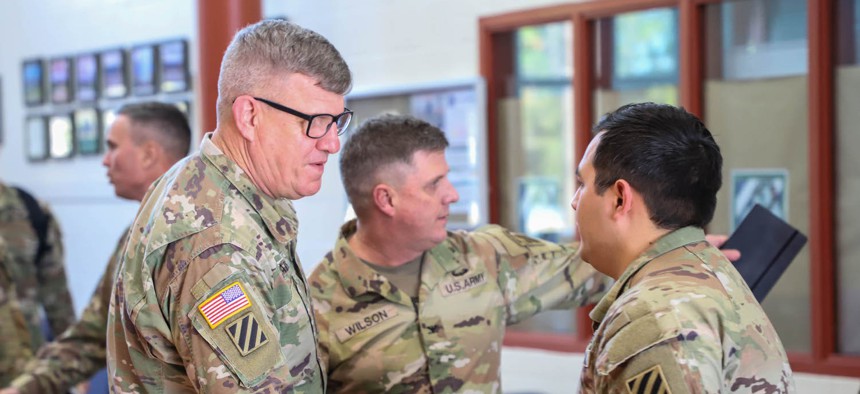The Army’s network is changing. But it still ‘needs work’

Gen. James Rainey, left, Commanding General of U.S. Army Futures Command, visits the Marne Innovation Center at Fort Stewart, Georgia, Dec. 11, 2023. U.S. Army / Pfc. Luciano Alcala
The service’s modernization chief said future war will be a conflict of systems where command and control will be central.
SAVANNAH, Ga.—The Army’s network is in transition—and there’s no going back to the days of having a tactical network divorced from the enterprise, service leaders say.
“You will never ever see the Army deploy a solely military network to conduct an operation again. I just do not see it,” Lt. Gen. John Morrison, the Army’s deputy chief of staff for command, control, communications, cyber and networks, said Tuesday at the Army’s Technical Exchange Meeting. “We are changing. Not just from a narrative perspective. Institutionally, we are simply changing.”
Morrison said the network is in an “excited state of transition,” as the service works to make real changes beyond rhetoric.
The Army has been working to provide a unified network that connects everything from the Pentagon to the battlefield so that information can be shared with the right people quickly and securely. But detangling dozens of network requirements has been a challenge, and the Army has had to make changes, such as like how the Army develops and buys software.
The service wants to keep building cloud capabilities, take advantage of 5G, and move forward with other capabilities that can be used across the entire network. The Army is rolling out unified security incident and event monitoring, which uses automation to scan the Army’s networks and sense abnormal activity to generate a “tip” that then “cues” a deeper look, Morrison told reporters.
“Our cybers lab is enabled to now do tipping and cueing…pulling that burden completely off. And so I feel like we are definitely heading in the right direction,” Morrison said.
During his keynote, Gen. James Rainey, head of Army Futures Command, said the current network “needs work” and stressed how important it is for commanders to communicate and share information.
“If you know anything about the Army, we have these things called warfighting functions. Now, we need to rapidly move to warfighting systems,” he said, arguing that any future war will be “system-on-system conflict” where command and control is critical.
“I challenge you to think about the command and control warfighting system,” he said, as an alternative to the term network. “Because it doesn't do anything in and of itself, but you can't do anything else without it.”



